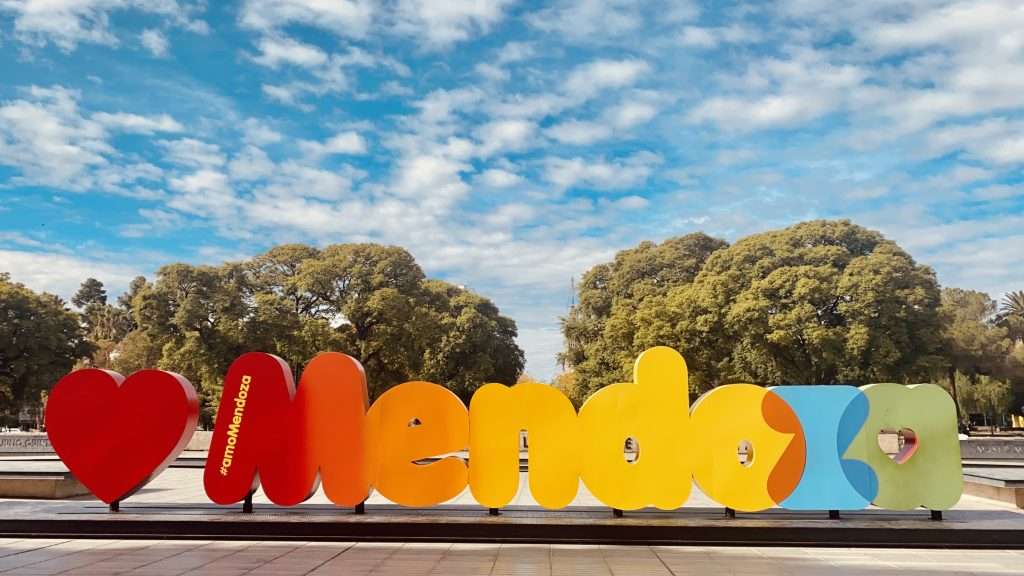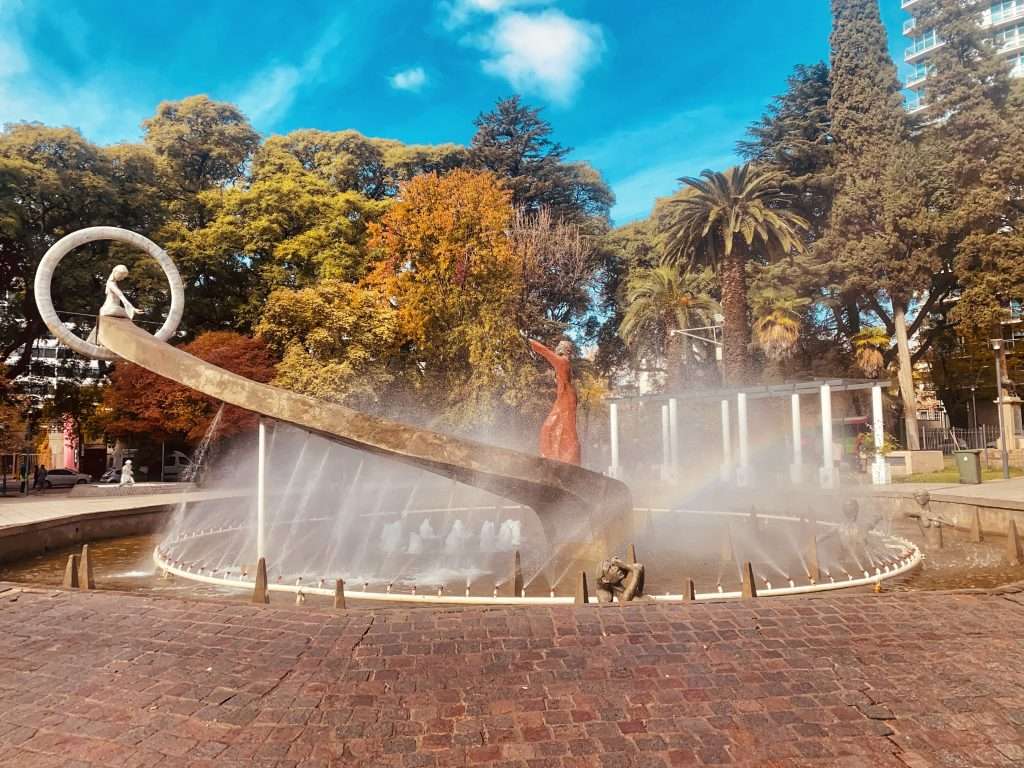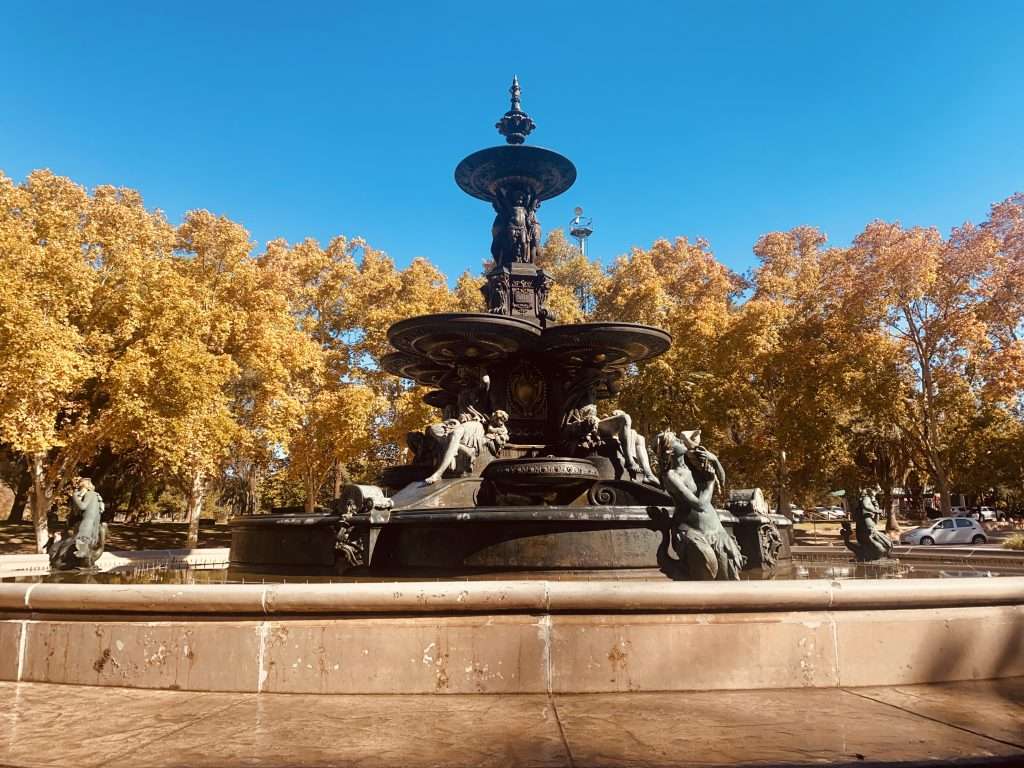One month in Mendoza, Argentina

I’ve come back to Argentina for the third year in a row, but instead of spending all my time based in Buenos Aires, this time I decided to give another city a try for the first month. I chose Mendoza for a few reasons. One, it’s just across the Andes from Santiago de Chile, where I had spent the last two months, and I had heard that the drive from Santiago to Mendoza (or vice versa) was epic. Two, I had seen and heard a lot of positive buzz about Mendoza on forums and YouTube. Three, it is a city with a metro population of just over one million people, so I felt that it would have enough to do for a month and I wouldn’t have to worry about getting bored.
My first impression of the city was that it looked very clean, with lots of tree-lined streets and low rise buildings punctuated by numerous leafy plazas. I arrived in early May, which is the height of autumn in the summer hemisphere. While the fall foliage in Mendoza is not quite as vibrant as what you might find in Patagonia, there were enough golden hues to make it properly feel like fall.

It seems that I arrived in an unseasonably chilly autumn, however. While there were some glorious sunny days with highs around 15-16 degrees Celsius, there were also many gray days (but very little rain) where it topped out around 12-13 degrees or less, and it often got down to nearly freezing at night. Fine weather for walking around, but I admit that I had less of a mood to explore thanks to the gloomy weather.
Getting Around Mendoza
The center of Mendoza, where you will most likely stay (and should stay), is very walkable. It is laid out on a grid, for the most part, with stoplights at most intersections – I mention this because I have been to a few Argentine cities where even stop signs are a rarity and it can be a little nerve-wracking to cross the street. Mendoza has a bus system and a single tram line called Tranvia which runs north to south – you might use this line if you wanted to go to the wineries in Maipu, for example. One of the quirks of Argentina is that the same transit card, Sube, is used in cities across the country. You will see signs for Sube recharging at various kiosks around the city center and it is this card that allows you to ride city buses and the Tranvia. Uber and Cabify also work well in Mendoza.
Calle Aristides Villanueva is the trendy bar and nightlife street which runs perpendicular to the Parque San Martin. The streets surrounding the Plaza Independencia, Plaza Italia, and Plaza Espana also have a large collection of restaurants and stylish cafes and coffee shops. There are Irish pubs, vegan cafes, pizzerias, parrillas, and a smattering of international options. I would recommend choosing a place to stay that is not too far from these areas (though not directly on Calle Aristides, due to the noise factor), if you want to be within walking distance of the action.
Things To Do In Mendoza
The primary word most people would freely associate with Mendoza is “wine,” and if you are an oenophile, you will surely enjoy exploring the region. There are multiple wineries in the center of the city as well as in the surrounding towns such as Maipu, Lujan de Cuyo, and Valle de Uco, which can be visited as part of a tour or independently. The wineries are open year round. However, if you would like to come during the prime harvest season and see Mendoza at its most vibrant (and crowded), I would advise timing your trip to include the Vendimia Grape Harvest Festival, which takes place around the end of February and culminates in the first week of March. The festival has more to offer than wine, of course – it includes live entertainment, a parade, fireworks, and much more.
Winter seasonal activities could include skiing or snowboarding – the closest resort to Mendoza city is Vallecitos, 80 km away. Further out there is Penitentes Ski Center, near the border with Chile, approximately 180 km away, and within Mendoza province but 419 km from Mendoza city is the highly rated Las Lenas Ski Resort, in the town of Malargue.
Between November 1 – April 30, it is possible to visit Aconcagua Provincial Park, 185 km from the city (from May-October, a special permit is required). Aconcagua is the highest peak in South America and the highest mountain in the world outside of the Himalayas. If you are not a serious trekker and just want to visit the base camp, it’s possible to get there by bus, or there are organized group day tours that include Aconcagua as well as the Inca Bridge and a couple of mountain villages.
An option which is available all year round is a day trip to the popular hot springs resort close to Mendoza, Termas de Cacheuta. There is a public water park there, as well as a hotel & spa by the same name, if you prefer not to mingle in the baths with the hoi polloi. While I didn’t make it there, I have read positive reviews and seen videos of the pools with some spectacular scenery in the background. Termas de Cacheuta has a very comprehensive website with information about the different options, as well as the ability to purchase tickets with or without transfer from the city.
There are also plenty of hiking opportunities near the city, with the most accessible option being the Cerro de la Gloria, located in a remote section of Parque San Martin. This vast park is definitely the crown jewel of Mendoza. It has a bit of everything, and reminded me a little of the Bosques de Palermo in Buenos Aires. There is a lake, a rose garden, an impressive fountain, cafes and food stands, and the list goes on. What I really appreciated is that even on a Sunday afternoon when half the city is seemingly there, it’s big enough that you can find a spot to be left alone in relative peace. There are a number of other green spaces and attractive plazas near the city center as well.

Shopping In Mendoza
Mendoza has several shopping malls, with the largest and closest to the city center being Mendoza Plaza Shopping. The area around Avenida Las Heras and Avenida San Martin is a very busy commercial nucleus with all kinds of shops ranging from clothing to souvenirs, plus cafes, banks, pharmacies. I wouldn’t call it a shoppers’ paradise (many locals will make the trek to Chile just to shop, so that should tell you something), but if you need something, you can surely find it. Mercado Central on Av. Las Heras is a smallish but decent food market. As for supermarkets, the two primary chains here are Carrefour and Vea. There is also a large Jumbo hypermarket a bit further away from the city center. This is not Buenos Aires, so don’t expect to find anything too “exotic” in terms of ingredients. The lack of supermarket variety felt a little disappointing to me for a metro of 1 million people – but it is what it is. (To be fair, most Buenos Aires supermarkets are pretty limited too, but at least there you have the Barrio Chino full of grocery stores selling imported items, and plenty of specialty shops).
Is Mendoza worth visiting for a month?
As I mentioned, the unexpectedly cold and gloomy weather hit me harder than I expected and I used much of my time in Mendoza to semi-hibernate, catch up on reading and writing. If I could do it all over again, I would probably try to visit the city during March. I am not sure I would spend a whole month here again, simply because I prefer more of a cosmopolitan, large city vibe. However, I know for plenty of other people, it’s just the opposite, and many will appreciate the chill vibes of Mendoza while still being “just enough” of a city.
Oddly, the place that Mendoza reminded me of the most (besides some of the quieter neighborhoods of northern Buenos Aires) was Montevideo, Uruguay. Not that they are really similar overall – Mendoza is adjacent to mountains and vineyards, while Montevideo is a humid coastal/port city – but in terms of size, and the feel of some of the neighborhoods with their mature tree-lined streets, shabby sidewalks, and beautiful parks – I think they are cities which would appeal to the same kind of traveler, those who like a more relaxed and human-size city as opposed to the typical South American urban jungle, or just need a break from such places. Mendoza, of course, is a lot more affordable than Montevideo – I rented a 1-bedroom apartment with full kitchen and washing machine, walking distance to Parque San Martin, for approximately $500 for the month.
In conclusion: Mendoza is pleasant, walkable, green, and feels quite safe, and although a month felt a little long for me, it’s not a bad option if you are looking for a medium-sized city that isn’t overwhelming. I assume it would be most enjoyable for a serious wine enthusiast and/or outdoorsy individual, especially around late summer during the harvest. Springtime would also likely be a lovely time to visit.

